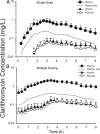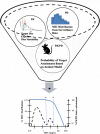Importance of relating efficacy measures to unbound drug concentrations for anti-infective agents
- PMID: 23554417
- PMCID: PMC3623378
- DOI: 10.1128/CMR.00092-12
Importance of relating efficacy measures to unbound drug concentrations for anti-infective agents
Abstract
For the optimization of dosing regimens of anti-infective agents, it is imperative to have a good understanding of pharmacokinetics (PK) and pharmacodynamics (PD). Whenever possible, drug efficacy needs to be related to unbound concentrations at the site of action. For anti-infective drugs, the infection site is typically located outside plasma, and a drug must diffuse through capillary membranes to reach its target. Disease- and drug-related factors can contribute to differential tissue distribution. As a result, the assumption that the plasma concentration of drugs represents a suitable surrogate of tissue concentrations may lead to erroneous conclusions. Quantifying drug exposure in tissues represents an opportunity to relate the pharmacologically active concentrations to an observed pharmacodynamic parameter, such as the MIC. Selection of an appropriate specimen to sample and the advantages and limitations of the available sampling techniques require careful consideration. Ultimately, the goal will be to assess the appropriateness of a drug and dosing regimen for a specific pathogen and infection.
Figures







Similar articles
-
PK-PD Compass: bringing infectious diseases pharmacometrics to the patient's bedside.J Pharmacokinet Pharmacodyn. 2017 Apr;44(2):161-177. doi: 10.1007/s10928-017-9518-0. Epub 2017 Mar 28. J Pharmacokinet Pharmacodyn. 2017. PMID: 28353185
-
Pharmacokinetics and Pharmacodynamics of Antimicrobials in Critically Ill Patients.Surg Infect (Larchmt). 2018 Feb/Mar;19(2):155-162. doi: 10.1089/sur.2017.262. Epub 2017 Dec 22. Surg Infect (Larchmt). 2018. PMID: 29272204
-
Selecting antibacterials for outpatient parenteral antimicrobial therapy : pharmacokinetic-pharmacodynamic considerations.Clin Pharmacokinet. 2003;42(9):793-817. doi: 10.2165/00003088-200342090-00002. Clin Pharmacokinet. 2003. PMID: 12882587 Review.
-
Class-dependent relevance of tissue distribution in the interpretation of anti-infective pharmacokinetic/pharmacodynamic indices.Int J Antimicrob Agents. 2010 May;35(5):431-8. doi: 10.1016/j.ijantimicag.2010.01.023. Int J Antimicrob Agents. 2010. PMID: 20219329 Review.
-
Achieving an optimal outcome in the treatment of infections. The role of clinical pharmacokinetics and pharmacodynamics of antimicrobials.Clin Pharmacokinet. 1999 Jul;37(1):1-16. doi: 10.2165/00003088-199937010-00001. Clin Pharmacokinet. 1999. PMID: 10451780 Review.
Cited by
-
Pharmacokinetic / pharmacodynamic relationships of liposomal amphotericin B and miltefosine in experimental visceral leishmaniasis.PLoS Negl Trop Dis. 2021 Mar 2;15(3):e0009013. doi: 10.1371/journal.pntd.0009013. eCollection 2021 Mar. PLoS Negl Trop Dis. 2021. PMID: 33651812 Free PMC article.
-
In Vitro Evaluation of Antimicrobial Peptide Tridecaptin M in Combination with Other Antibiotics against Multidrug Resistant Acinetobacter baumannii.Molecules. 2020 Jul 17;25(14):3255. doi: 10.3390/molecules25143255. Molecules. 2020. PMID: 32708842 Free PMC article.
-
Population Pharmacokinetic Modelling of Ceftazidime and Avibactam in the Plasma and Epithelial Lining Fluid of Healthy Volunteers.Drugs R D. 2018 Sep;18(3):221-230. doi: 10.1007/s40268-018-0241-0. Drugs R D. 2018. PMID: 30054895 Free PMC article. Clinical Trial.
-
Simultaneous Semimechanistic Population Analyses of Levofloxacin in Plasma, Lung, and Prostate To Describe the Influence of Efflux Transporters on Drug Distribution following Intravenous and Intratracheal Administration.Antimicrob Agents Chemother. 2015 Nov 30;60(2):946-54. doi: 10.1128/AAC.02317-15. Print 2016 Feb. Antimicrob Agents Chemother. 2015. PMID: 26621623 Free PMC article.
-
A Data-Mining Approach for the Quantitative Assessment of Physicochemical Properties of Molecular Compounds in the Skin Flux.AAPS PharmSciTech. 2021 Mar 25;22(3):117. doi: 10.1208/s12249-021-01988-x. AAPS PharmSciTech. 2021. PMID: 33768360
References
-
- Kratochwil NA, Huber W, Müller F, Kansy M, Gerber PR. 2002. Predicting plasma protein binding of drugs: a new approach. Biochem. Pharmacol. 64:1355–1374 - PubMed
-
- Craig W, Welling P. 1977. Protein binding of antimicrobials: clinical pharmacokinetic and therapeutic implications. Clin. Pharmacokinet. 2:252–268 - PubMed
-
- Toutain P, Bousquet-Melou A. 2002. Free drug fraction vs free drug concentration: a matter of frequent confusion. J. Vet. Pharmacol. Ther. 25:460–463 - PubMed
-
- Perry T, Schentag JJ. 2001. Clinical use of ceftriaxone: a pharmacokinetic-pharmacodynamic perspective on the impact of minimum inhibitory concentration and serum protein binding. Clin. Pharmacokinet. 40:685–694 - PubMed
Publication types
MeSH terms
Substances
Grants and funding
LinkOut - more resources
Full Text Sources
Other Literature Sources
Medical
Research Materials

